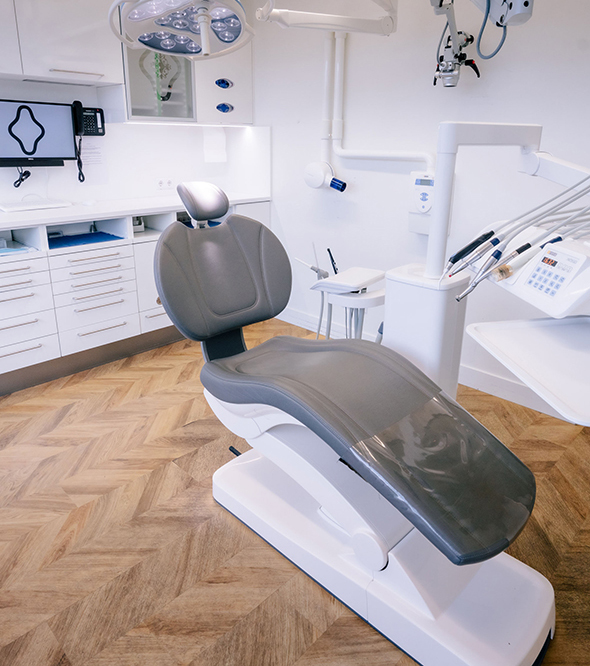Tandarts Jan van Galen
Implant-retained dentures
Implant-retained dentures are snapped into place on the implants attached to your jawbone. An implant-retained denture is a solution if your traditional denture does not fit any more, for instance because of jaw resorption, or if you only need a denture for a few teeth. An implant-retained denture is very firm, so you will be able to eat without problems and will not feel any pressure points. Having an implant-retained denture placed at Tandartspraktijk Jan van Galen in Amsterdam involves:
Tandartspraktijk Jan van Galen dentists have ample experience placing implants and crafting dental prostheses. You will find our practice on Jan van Galenstraat in Amsterdam West.
My traditional denture didn’t fit properly any more, which made it difficult to speak and eat. An implant-retained denture has really solved the problem for me. It is firmly attached, I can eat everything again and you can’t see it!
The difference between an implant-retained denture and a traditional denture
An implant-retained denture and a traditional denture are both dental prostheses which replace your own teeth. A traditional denture replaces all the teeth with a prosthesis which is loose in the mouth while an implant-retained denture can also be used to replace only some of the teeth and is always fixed to the jaw using implants. Your dentist will provide advice if you have to choose between an implant-retained denture and a traditional denture. Often a traditional denture is preferred, but this is not always an option. If there is not enough bone tissue in the jaw, a traditional denture is not an option and an implant-retained denture is a good solution. If your traditional denture is painful or you need a partial prosthesis, an implant-retained denture is the best choice too.
Treatment: placing an implant-retained denture
Step 1: taking an impression of the jaw
During the first consultation we discuss your situation and the dentist takes pictures and impressions of the jaw in order to determine where the implants must be placed. The dental laboratory can start working on a preliminary prosthesis design with these impressions.
Step 2: placing the implants
At least two implants are needed for an implant-retained denture, both above and below. The dentist makes an incision in the gums and drills a hole in the jawbone under local anaesthesia, then places the implant.
Step 3: healing
The bone must grow onto the implants. How long this takes depends on the speed of healing. Be prepared to wait six weeks to a few months. In the healing period you use the traditional denture that you already have or a temporary structure is provided.
Step 4: making your implant-retained denture
During the healing period the dental laboratory is busy crafting your implant-retained denture. In order to make the implant-retained denture exactly as you would like it, we ask you to come to the practice regularly in order to try out and evaluate the prosthesis.
Step 5: placing the implant-retained denture
Once the implants are entirely fused to the bone and you have approved the implant-retained denture, we place your new prosthesis.
Step 6: aftercare
You receive advice on how to take care of your implant-retained denture and gums, because oral hygiene is also very important with an implant-retained denture. We ask you to schedule regular check-ups.
Advantages and disadvantages of an implant-retained denture
We have made a list of the advantages and disadvantages of an implant-retained denture.
Advantages of an implant-retained denture
Disadvantages of an implant-retained denture
Tandartspraktijk Jan van Galen in Amsterdam provided excellent assistance. I’m happy that my implant-retained denture doesn’t slide when I talk or laugh. And the placing of the implants wasn’t as bad as I expected.
Frequently asked questions about an implant-retained denture
Is it painful to have an implant-retained denture placed?
Having an implant-retained denture placed does not hurt. The implants are placed under local anaesthesia, so this does not bother you either. The afterpain that you might experience can be compared to the pain after having a tooth extracted or having a root canal treatment and can be relieved with paracetamol.
How do I clean my implant-retained denture?
An implant-retained denture can be easily snapped on and off. Take care to brush your implant-retained denture with a prosthesis brush after every meal. Also clean all your teeth with a cleaning agent regularly. Above all, remember to clean the parts under your prosthesis in order to prevent problems with your jaw, gums and implant-retained denture.
Do I still have to go to the dentist if I have an implant-retained denture?
Yes. As with normal teeth, we advise you to pay the dentist a visit every six months for check-ups and thorough cleaning. Oral hygiene is particularly important with an implant-retained denture.
Does the insurance cover an implant-retained denture?
The cost of placing implants and the implant-retained denture is reimbursed by the basic insurance if certain conditions are met. One of the conditions is that the jaw is completely toothless and severely shrunken. The insurance company must approve the treatment beforehand and allocate the reimbursement. For more information about reimbursement, contact your insurance company.
Can implant-retained dentures become discoloured?
An implant-retained denture can become discoloured just the same as normal teeth, for instance from eating certain foods. Be careful if you smoke or drink tea or coffee regularly. Keep your prosthesis clean in order to prevent discolouration.
How long will an implant-retained denture last?
An implant-retained denture lasts for five to eight years on average, provided you take good care of it and have it checked regularly by a dentist.
Can I eat anything with an implant-retained denture?
Yes, you can eat anything. An implant-retained denture is firmly attached to the implants in the mouth, which enables you to eat without inconvenience.
How do I register as a new patient?
Even if you have another dentist, you can have your implant-retained denture crafted and placed by Tandartspraktijk Jan van Galen. Complete the registration form for new patients for this. We will contact you as soon as possible.
Make an appointment
Call 020 618 0074 for more information or make an appointment at our practice in Amsterdam to have an implant-retained denture placed.

